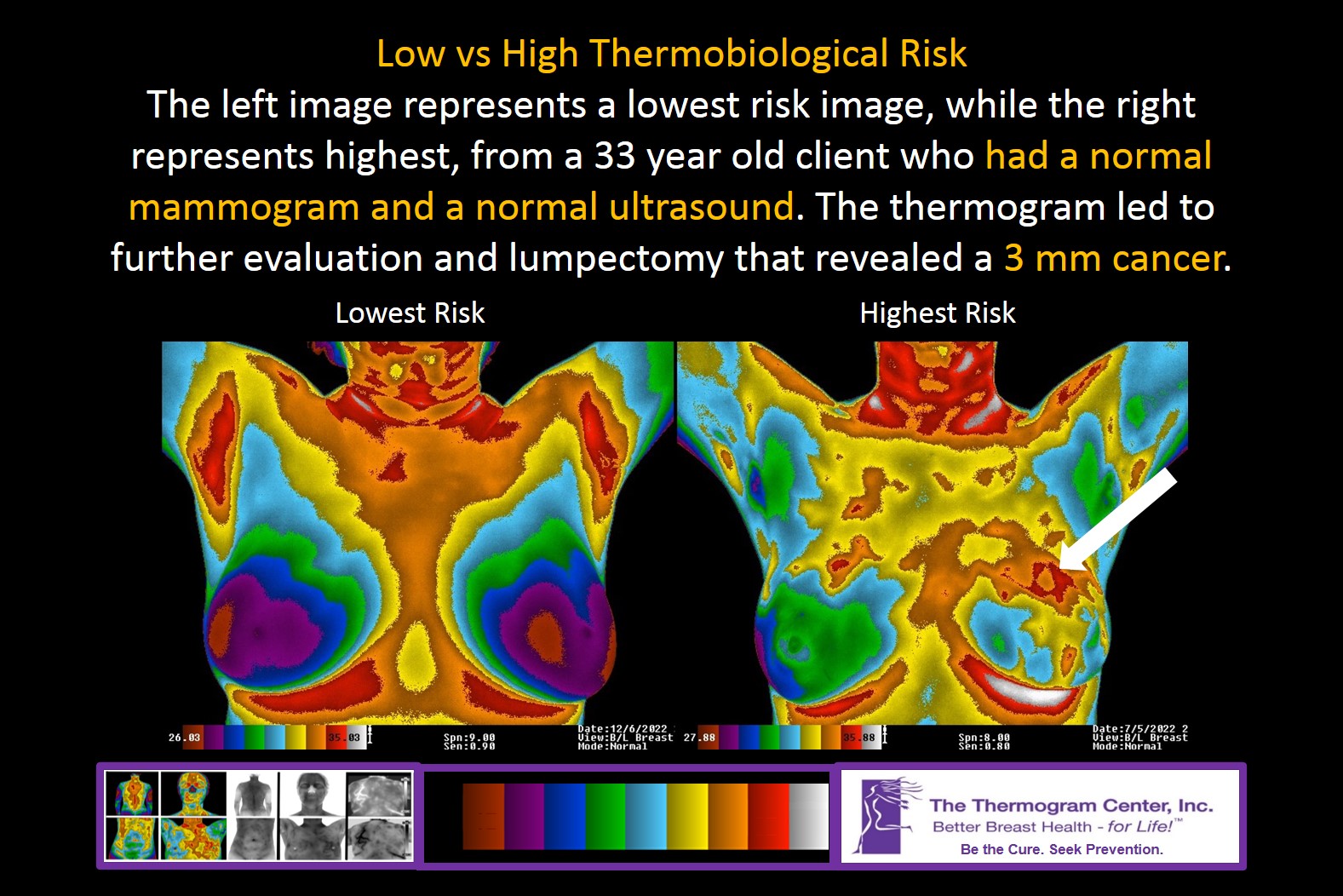The Thermogram Center employs Advanced Thermography in the form of Risk Assessing Thermal Imaging (RATI)
Mammograms and Detection
Mammograms are promoted by many organizations for prevention. But of what? DEATH… if “early detection” is obtained. But early detection is still “after the fact:” cancer has occurred. True prevention would imply no breast cancer manifests. When Risk Assessing Thermal Imaging, a “before the fact” test, is combined with preventive education materials (like Better Breast Health – for Life!™), with a client who is proactively managing risk factors, true prevention is a more likely possibility. Click here to learn more.
Risk Assessing Thermal Imaging and Prevention
If a woman learns through her thermal imaging that she is at high risk for developing cancer, she may have an early opportunity to intervene and reverse the situation through risk factor management. If she did not know she was at risk, would she have had this opportunity? On the other hand, why would a woman at lowest risk be overly anxious and consider aggressively managing every risk factor possible?
“I like to think of my risk assessment as a way of understanding how all the risk factors are collectively impacting my breast health at any given point in time. If I don’t like the results, I make changes in one or more of these factors and monitor the impact with a new risk assessment. Over time, I hope to reduce my risk ratings, improve my breast health, and avoid breast cancer.” – Tina
Thermobiological Risk Ratings
Risk Assessing Thermal Imaging assesses each breast’s cancer risk with a Thermobiological Risk Rating. On a scale of 1 to 5, each number represents the level of risk for developing breast cancer, with 1 being lowest and 5 being highest. Think of it as a way of objectively monitoring the collective effect of 35+ breast cancer risk factors on each breast.
- TH1 – Lowest Risk
- TH2 – Low Risk
- TH3 – Medium Risk
- TH4 – High Risk
- TH5 – Highest Risk
Identifying high thermobiological risk clients early provides opportunities for intervention and supports proactive efforts to fight breast cancer development.
The numbering system also provides objectivity and relativity over time, helping clients and their health providers make more informed decisions regarding any need for further evaluation, while objectively monitoring the results of treatment and anti-inflammatory/risk reduction efforts.
Monitor your level of risk over time. If you are uncomfortable with your level or risk… or it is increasing over time… you can intervene and act.
We can show you potential risk factors in your images, educate you on likely causes, and provide action steps, tools and resources to support prevention and a healthier tomorrow.
While approximately 95% of our first-time clients have thermal findings/breast inflammation, approximately 80% see improving findings/inflammation and subsequent risk reduction at their next visit.
Risk Assessing Thermal Imaging and Early Breast Cancer Detection
The average cancer takes 7-14 years to become large enough to be visible on a mammogram, typically at 3 mm, after ~25 multiplication cycles and with between 286 million and 4.5 trillion cancer cells. But active cancers begin creating a blood supply at about 1/5 mm and thermograms may see warning signs with as few as 256 active cancer cells.
Thermal imaging looks for signs of developing blood supply, as well as signs of risk contributing to inflammation.
Active cancer cells are blood thirsty and stimulate the development of new blood vessels to feed them (neoangiogenesis). These vascular formations are one thermobiological sign that cancer may be developing. There is a known standard for a low risk thermogram. Breast disease causes thermograms to significantly deviate from that standard.
Low risk breast thermograms show symmetrical heat patterns and similar temperatures in the breasts, while high risk thermograms do not:

While this client did not have time to reverse the situation, she was able to obtain a relatively early diagnosis.
Estrogen Stimulation and Hormonal Grades
Your interpretive report includes grayscale images depicting the vascular dilation in the breasts and a Hormonal Grade, which increases with estrogen stimulation. This may be important because the National Institute of Health reports that breast tissue can hold 10 to 50 times more estrogen than the levels revealed in typical blood tests, and because prolonged exposure to excess estrogen is a significant risk factor for breast cancer development. Hormonal Grades are on a scale of 0-4 and increase with estrogen stimulation.

If a woman has a higher than expected Hormonal Grade, she can work with a qualified (functional) health provider proficient at testing and treating estrogen metabolism and elimination, supporting cancer prevention. While there are prescription drugs available to reduce estrogen stimulation, there are also many effective natural and nutritional methods.
